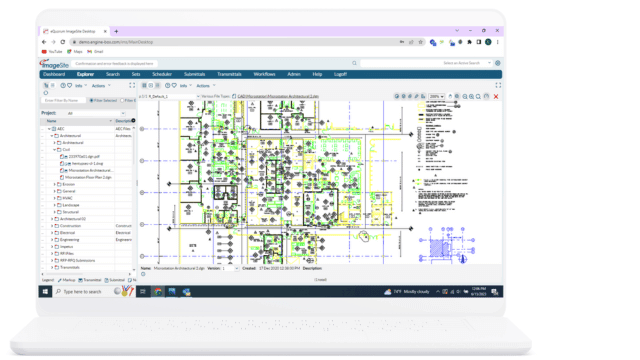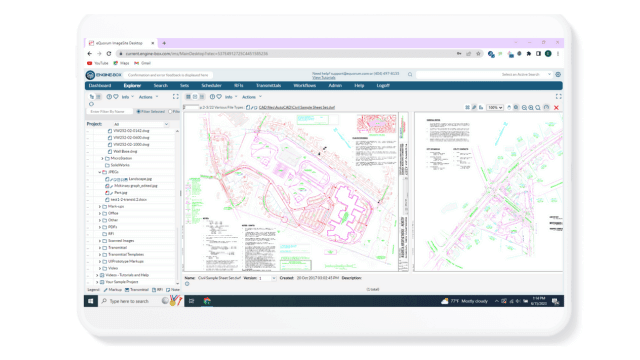Features of an Engineering Document Management System
Features of an Engineering Document Management System
An electronic document management system (EDMS) helps organizations store, secure, and control digital files. EDMS software has been around for decades now, yet the disparity between each system suggests many of them lack the functionality engineering-based companies require. Document management systems often cater to specific industries (i.e., marketing, sales, finance, etc.), so while organizations may seek a one-size-fits-all solution, it’s unlikely they will find one that checks all the boxes.
Workflow Automation
According to a report by McKinsey, companies can automate roughly 45 percent of paid activities, and menial, yet necessary, tasks are estimated to set them back nearly $2 trillion in annual wages. This demonstrates the opportunity in implementing a workflow and document management system, as many of these tasks, which are essential to engineering workflows, can be automated.
Automating document actions, as they move between workflow steps, ensures workers can focus on important tasks, as opposed to repetitive document-based actions. Additionally, creating an environment where collaborators can visualize a workflow and its various steps ensures workers have a clear understanding of what they contribute to a project, and the deadlines they need to meet.
Document Security
Issues over document security have presented significant challenges for engineering-based companies maintaining digital records. In 2020 alone, the number of data breaches surpassed 1,000, exposing more than 150 million records [Statista]. Microsoft, along with the U.S. Department of Energy and its National Nuclear Security Administration warned the public about the risks posed by cyber-attacks, as there has been a substantial increase in the number of threats to both public sector and private sector organizations [The New York Times]. The attacks derive from both independent hackers and foreign governments.
Maintaining security over files and documents is mission-critical for engineering firms, as cyber-attacks, such as ransomware attacks, can cause major disruptions in critical processes, ranging from drafting and design workflows, to reviews and approvals. Fortunately, an effective electronic document management system helps organizations mitigate the risk of cyber-attacks and maintain control over their engineering files and documents.
ImageSite, for example, provides the option for several authentication protocols to ensure only permissioned users have access to the system and includes access control functionality that enables system admins to create security profiles at multiple levels within the system. The software also safeguards files that are stored and in transit using both AES and SSL encryption protocols, respectively, guaranteeing privacy from the server to the device.
Document Version Control
Document version control is a critical function of a document management system. It helps workers determine which version of a document is current and creates a single source of truth across an organization. To make things easier, version control enables organizations to locate back-versions of documents, helping employees rectify mistakes or changes to an existing document.
Studies show professionals require 18 minutes, on average, to locate a file or document manually. The time it takes to locate a document increases if there are multiple versions of the documents that don’t utilize a standardized versioning scheme. For this reason, ImageSite ensures files are automatically versioned when they re-enter the system and are easily searched for and found.
Automating version control ensures everyone is using a standard versioning scheme and the correct version of a file or document is located and distributed to recipients. While version control is a common feature among professional document management systems, it is essential for concurrent processes, such as large engineering projects, as it eliminates the potential for confusion and rework.
Notifications
Notifications play a key role in document-centric communications as they inform workers when changes are made within the document management system and often defines deadlines to ensure the timeliness of projects.
ImageSite notifications are automated, so there is no time wasted sending emails. Instead, the system utilizes templates to send messages either internally (in the EDMS), externally (via email), or through both methods to provide workers with critical information regarding project drawings or documents. Users can design templates using custom variables so they have access to the information they need in a familiar format and familiar language.
Summary
Today, more and more businesses rely on EDMS solutions to centralize key elements of their engineering processes, and choosing the right system is paramount to their success. ImageSite provides mission-critical functionality for engineering companies, including additional features such as drawing markups (redlining), a Transmittals module, and an RFI/submittals module.
eQuorum also offers a Cloud variation of the software (i.e., EngineBox.com) for organizations who need a document management system but don’t want to maintain their own IT infrastructure. If you want to learn more about ImageSite and Engine-Box, click here. Discover here why our cloud document management software and engineering workflow solution is trusted by many industry leaders worldwide.
Additional EDMS Features
Our EDMS solutions
ImageSite and EngineBox are eQuorum’s robust workflow and document management solutions, created to help workers manage their essential workflows while maintaining complete control over their engineering files and documents. Not only do they provide a secure collaboration site for workers, but they also help organizations manage document distribution with third parties like vendors, contractors, and customers. Both systems are offered at a competitive price, enabling organizations to get a quick return on their investment by providing the features and functionality needed to help organizations improve efficiency, productivity, and collaboration. Companies can choose from concurrent user subscriptions or named user subscriptions, ensuring organizations have subscription options that make sense for their business.

ImageSite®
Our single source engineering workflow and document management system. Built in HTML5 so there is no software to deploy to client computers or mobile apps to download. Offered as an On-premise or Private Cloud system.
EngineBox™
EngineBox is a cloud based workflow and document management version of ImageSite that resides outside the corporate network.
Our EDMS solutions
ImageSite and EngineBox are eQuorum’s robust workflow and document management solutions, created to help workers manage their essential workflows while maintaining complete control over their engineering files and documents. Not only do they provide a secure collaboration site for workers, but they also help organizations manage document distribution with third parties like vendors, contractors, and customers. Both systems are offered at a competitive price, enabling organizations to get a quick return on their investment by providing the features and functionality needed to help organizations improve efficiency, productivity, and collaboration. Companies can choose from concurrent user subscriptions or named user subscriptions, ensuring organizations have subscription options that make sense for their business.

EngineBox™
EngineBox is a cloud based workflow and document management version of ImageSite that resides outside the corporate network.
The eQuorum Customer Promise
In 2005, eQuorum developed the first all browser-based EDMS. The system, although for on-premise use, was still created to remove client software and JAVA from user computers and allow users to have a single viewer based on the simple navigation functionality of browsers. Today, eQuorum provides that same application in a private Cloud or a SaaS Cloud option. We can do this because we are, and have always been, browser-based, understanding the enhanced speed, security, and usability of this technology.
With the abundance of document management systems on the market today, there’s no doubt that choosing the right Cloud document management software can be a difficult decision. eQuorum is here to provide a comprehensive, powerful, and most importantly – affordable Cloud document management solution. We believe in providing real value to our customers by eliminating unnecessary costs, providing industry-leading functionality, and equipping your team with the right tools using cutting edge technology to bring your products to market faster.
eQuorum®
We specialize in engineering workflow and document management. Our comprehensive, yet easy-to-use software provides the solution to manage data from design to manufacturing and production, to sales, support and administration.